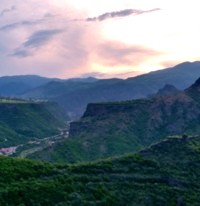The Palace of Shaki Khans
Much more contemporary is the the Palace of Shaki Khans, completed in 1797 as a summer residence - around the same time as the Presidential White House in Washington DC. But the Khan's lifestyle was somewhat different to that of George Washington or John Adams. The Khans (kings - after Genghis Kahn and the Khanates) typically had five wives and a household staffed by concubines and other women and managed by eunuchs (castrated males). In order to ensure the purity of the male succession sons who had reached puberty were also moved out of home. So the family household needed to be insulated from the outside world and this was evident in the original architecture of the building.
As I mention later, in Armenia, the Romantic Poet Lord Byron visited this region in 1876 on his Grand Tour. He subsequently explored the Khan's domestic arrangements in his epic satirical poem Don Juan, in which the eponymous hero is smuggled into a Turkish seraglio (harem) as a woman and is kept a secret by several girls for their pleasure.
This was the first time that the general public in Britain and the US had become aware of what was actually a very common upper-class domestic arrangement across the one-time Khanates, including China and India. The poem was published sequentially in a series of Cantos. It outraged polite society for its salacious content and thus became immensely popular, with each new Canto awaited like new episodes of Game of Thrones or Star Wars. In a later Canto 'The Don' becomes a favourite in the Court of Catherine the Great of Russia and one of her numerous lovers. After his earlier, less readable, epic poem, Childe Harold, Byron had been famously condemned as 'mad, bad and dangerous to know'. Now he became enormously wealthy, as well as notorious - a model for the Byronic Hero - like the Bronte's: Heathcliff and Rochester and Pushkin's: Eugene Onegin - 'hero' of Tchaikovsky's eponymous opera. Read more...
But this idyllic lifestyle (for the Khan) did not continue for long after building this palace, because, as we have seen, 16 years later the Khanate fell (a second time) to the Russian Empire - under Alexander I, Catherine the Great's grandson.
The Palace of Shaki Khans - its beauty has ensured its survival
Within the fortress grounds is another Armenian Christian Church - now a museum
The palace was then used as offices by local government and suffered accordingly - drawing-pins in the woodwork?
In 1848 Hussein Khan Mushtag's grandson, together with locally famous poet Karim agha Fateh, set about its restoration. In the 1950's it was renovated further, during Soviet times, as a national treasure then, more recently, when seeking it's nomination for UNESCO World Heritage listing, important to tourism.
Visiting this jewel box is via a guided tour (don't touch the walls). Photos are banned inside so I can't show you pictures of the interior - but you can see one in Wikipedia and if you can find Joanna Lumley's Silk Tour Adventures on your device, there's quite a long segment, particularly admiring the windows (golly gosh). Its beauty has ensured its survival from among a larger complex of palaces and administrative buildings, no longer extant, which once resided within the walls of the Sheki Khans' Fortress. Yet they are not all gone. Within the grounds we found another interesting building that turned out to be another Armenian Christian Church, used according to the sign, as a museum (closed).
The following day we crossed into Georgia
Crossing to Georgia
There are more images in the Azerbaijan Album See more...

